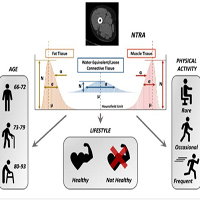Testing soft tissue radiodensity parameters interplay with age and self-reported physical activity

Accepted: 5 July 2021
HTML: 3
All claims expressed in this article are solely those of the authors and do not necessarily represent those of their affiliated organizations, or those of the publisher, the editors and the reviewers. Any product that may be evaluated in this article or claim that may be made by its manufacturer is not guaranteed or endorsed by the publisher.
Authors
Aging well is directly associated to a healthy lifestyle. The focus of this paper is to relate individual wellness with medical image features. Non-linear trimodal regression analysis (NTRA) is a novel method that models the radiodensitometric distributions of x-ray computed tomography (CT) cross-sections. It generates 11 patient-specific parameters that describe the quality and quantity of muscle, fat, and connective tissues. In this research, the relationship of these 11 NTRA parameters with age, physical activity, and lifestyle is investigated in the 3,157 elderly volunteers AGES-I dataset. First, univariate statistical analyses were performed, and subjects were grouped by age and self-reported past (youth–midlife) and present (within 12 months of the survey) physical activity to ascertain which parameters were the most influential. Then, machine learning (ML) analyses were conducted to classify patients using NTRA parameters as input features for three ML algorithms. ML is also used to classify a Lifestyle index using the age groups. This classification analysis yielded robust results with the lifestyle index underlying the relevant differences of the soft tissues between age groups, especially in fat and connective tissue. Univariate statistical models suggested that NTRA parameters may be susceptible to age and differences between past and present physical activity levels. Moreover, for both age and physical activity, lean muscle parameters expressed more significant variation than fat and connective tissues.
How to Cite
PAGEPress has chosen to apply the Creative Commons Attribution NonCommercial 4.0 International License (CC BY-NC 4.0) to all manuscripts to be published.

 https://doi.org/10.4081/ejtm.2021.9929
https://doi.org/10.4081/ejtm.2021.9929



